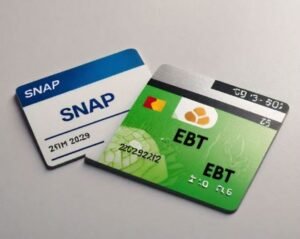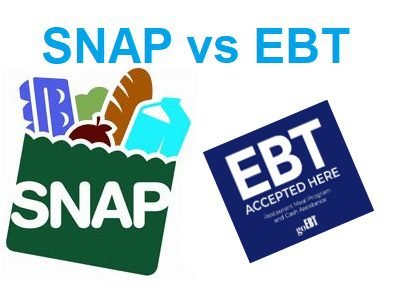When it comes to food assistance programs in the United States, two terms often come up: SNAP and EBT. SNAP vs EBT: Key Differences: While many people use these terms interchangeably, they refer to different aspects of the same system. For those who rely on food assistance, understanding the differences between SNAP vs EBT is crucial. Is it a simple guide to understanding food benefits, or are there critical details being missed? In this article, we’ll explore the key differences between SNAP and EBT, highlight common misunderstandings, and clarify what each term means.
What is SNAP?
SNAP (Supplemental Nutrition Assistance Program) is a federal program that provides food assistance to low-income individuals and families. This program aims to help those struggling with food insecurity by offering monthly benefits to purchase eligible food items. SNAP is available to U.S. citizens and legal residents who meet specific income and household criteria.
When discussing SNAP vs EBT, it’s essential to recognize that SNAP refers to the actual food assistance program, not the way the benefits are distributed. The program is designed to ensure that recipients can purchase nutritious food, improving access to healthy meals for those in need.

What is EBT?
EBT, or Electronic Benefit Transfer, is the system used to distribute SNAP benefits to eligible recipients. Instead of receiving paper food stamps, participants are issued an EBT card, which functions like a debit card. The EBT card is loaded with the recipient’s monthly SNAP benefits, which can then be used to buy eligible food items at participating stores.
While SNAP vs EBT is a common debate, it’s important to understand that EBT is simply the method of distribution for the benefits provided by the SNAP program. The two terms are interconnected, but they represent different parts of the same process: SNAP is the program, and EBT is the system for accessing those benefits.

SNAP vs EBT: Key Differences
Now that we’ve defined each term, let’s explore the key differences between SNAP and EBT in more detail.
1. Nature of the Terms
The most fundamental difference between SNAP and EBT is that SNAP refers to the food assistance program, while EBT refers to the electronic system used to distribute those benefits. This distinction is often misunderstood.
- SNAP is the program that provides eligible individuals with benefits to purchase food.
- EBT is the method by which recipients access their benefits (via the EBT card).
This may seem like a simple difference, but understanding it is crucial for understanding how food assistance works. For example, when people talk about “using their SNAP card,” they’re actually referring to the EBT card used to access the SNAP benefits.
2. Program vs. Distribution Method
Another key difference between SNAP and EBT is their function in the process of food assistance. SNAP is a federal program that provides financial assistance for food, and the amount of assistance is determined based on household income and other factors. On the other hand, EBT is simply the distribution method for delivering the benefits granted under SNAP.
In short, SNAP provides the benefits, while EBT is the way those benefits are accessed and used. If you’re using your EBT card at a grocery store, you’re accessing SNAP benefits, but the SNAP vs EBT distinction remains important to understand.
3. Use of the Term SNAP vs EBT in Different Contexts
The way people use the terms SNAP and EBT can cause confusion. For instance, you might hear someone say “I use SNAP to buy groceries,” but technically, what they mean is they use their EBT card to access the benefits provided by the SNAP program. This is an important nuance to grasp, especially if you’re navigating the system or helping someone else do so.
In some cases, people might mistakenly believe that SNAP is a type of card or a specific way to purchase food, but in reality, the EBT card is the physical tool used to access the benefits from the SNAP program. Clarifying these terms helps avoid misunderstanding and ensures that individuals are better informed about the benefits they are receiving.

4. Eligibility and Program Changes
While SNAP is a federally funded program that is designed to support individuals and families in need, EBT is not a program on its own. It’s simply a technological tool designed to help SNAP participants access their benefits.
Changes to the SNAP program (such as benefit increases or eligibility modifications) can influence the amount of money a person receives, but those changes are processed through the EBT system. So, when individuals hear about changes to the SNAP program, they might not immediately see the effects on their EBT cards, but adjustments are made through the system, which eventually reflects in the card’s balance.
5. Use of EBT in Other Assistance Programs
Although SNAP is the primary program for food assistance, there are other benefits distributed via EBT cards as well. For example, some states provide benefits for cash assistance or WIC (Women, Infants, and Children) programs via EBT cards.
The EBT system can be used for various types of assistance programs beyond just SNAP, which means recipients might be using the same EBT card for different purposes. This is another key difference to consider when talking about SNAP vs EBT, as the EBT card might serve multiple functions depending on the state and the specific programs in place.
Why Understanding the Difference Between SNAP and EBT is Important
Understanding SNAP vs EBT is crucial for anyone navigating the food assistance system. Recognizing that SNAP refers to the program and EBT is the delivery method can help users better manage their benefits and avoid confusion.
Additionally, knowing the key differences between these terms can help people ask the right questions when seeking assistance. For example, someone new to the system may wonder why they can’t use their EBT card for something that’s outside of SNAP’s eligible categories. In such cases, understanding the distinction between SNAP and EBT helps clarify that the limitations are due to the program rules and not the EBT system itself.
Potential Missed Details
Despite the clarity of the SNAP vs EBT distinction, there are still missed details that can confuse recipients. For example:
- EBT card usage might be restricted by retailer participation, meaning not all stores may accept EBT cards for SNAP purchases.
- SNAP eligibility requirements can change, making it unclear for applicants how and when they will receive benefits.
- State-specific rules for SNAP benefits, such as restrictions on non-food items or the use of SNAP at farmers markets, can add layers of complexity.
The nuances involved in SNAP vs EBT highlight how important it is for recipients to stay informed and updated about changes to their benefits and how to use them.

Conclusion: A Simple Guide or Missed Details?
So, is the SNAP vs EBT debate a simple guide to understanding food assistance, or is it filled with missed details? The answer is both. While the basic concepts of SNAP and EBT are straightforward, the differences, nuances, and rules surrounding them can sometimes cause confusion. By recognizing that SNAP is the program that provides food benefits and EBT is the system used to access those benefits, individuals can better navigate the process and avoid common misunderstandings.
In the end, understanding these key differences is essential for anyone relying on food assistance. While it may seem like a simple distinction, the impact of understanding the full scope of SNAP vs EBT can make a significant difference in how recipients manage and use their benefits. The key takeaway? Clarity and education about SNAP vs EBT are critical, and those who take the time to learn these differences can better access the support they need.




